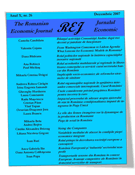Abstract:
This paper addresses the issue of causal relationships between trade openness and financial development in Tunisia over the period 1973-2013. We used the Autoregressive Distributed Lag method considering the ratio of Liquid liabilities, Private credit and Stock market capitalization as financial development indicators (all per cent of GDP). The sum of export and import as a percentage of GDP is the measurement of trade openness. Our estimates imply that the long and short-run relationships are different. At long run, trade openness is stimulated by liquid liabilities level while it is negatively affected by the level of private credit and the stock market capitalization. In contrast, the main short-run responses of financial development and openness to international trade are not significant. Moreover, the results reveal a bi-directional causality between private credit and trade openness but a direct unidirectional causality running from financial intermediaries’ ability to mobilize funds, the size of stock market and trade openness in Tunisia. The policy implications of this study appeared clear. The overcoming of the institutional weaknesses and the establishment of transparent rules are likely to improve the efficiency of the banking sector and the stock market and so to strengthen the foreign trade in Tunisia.
